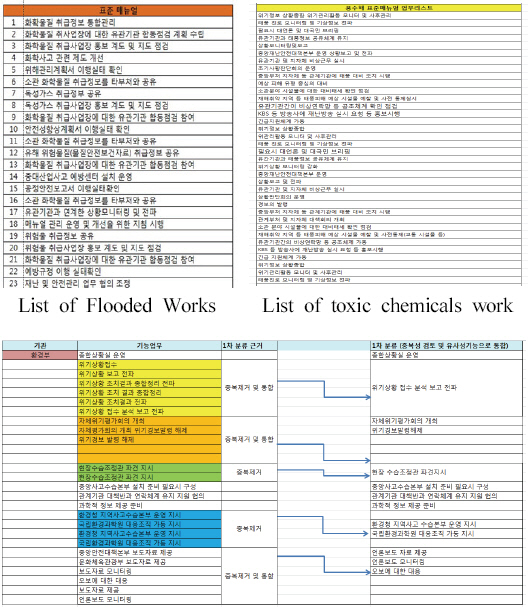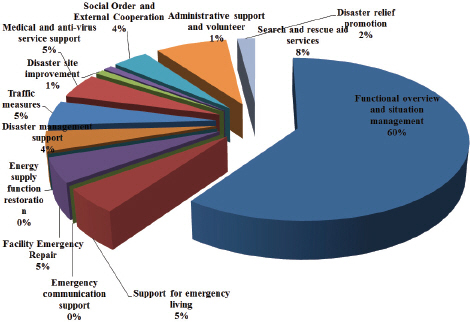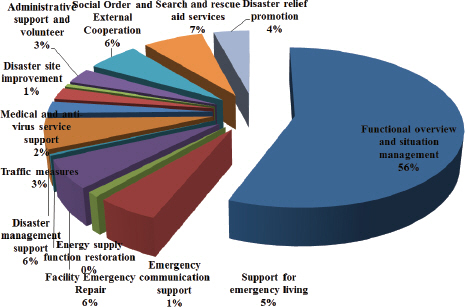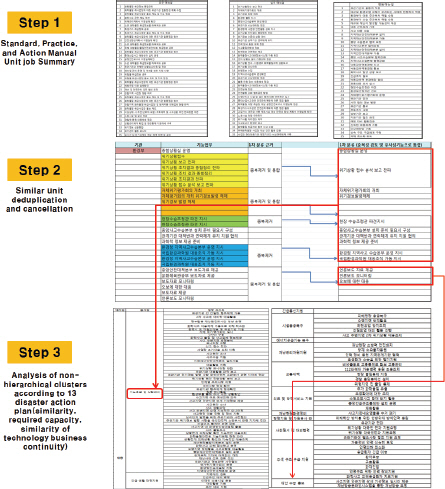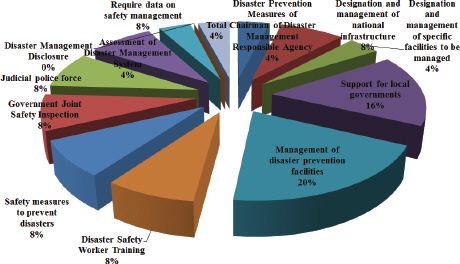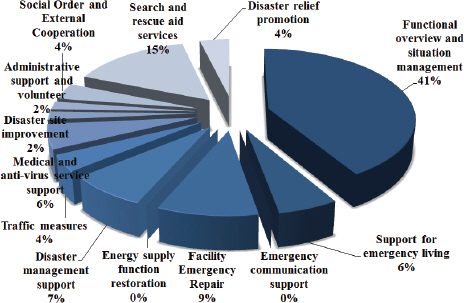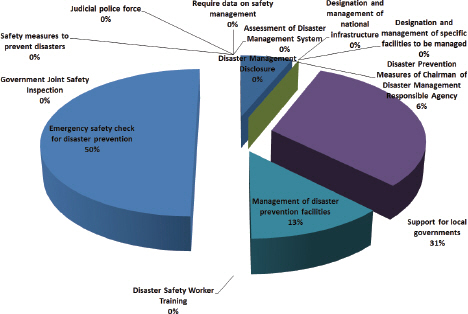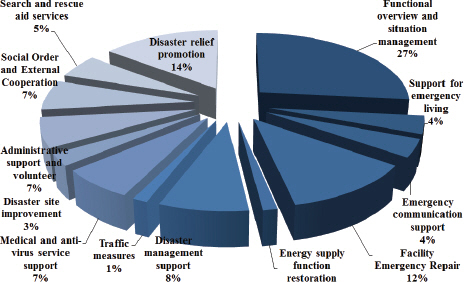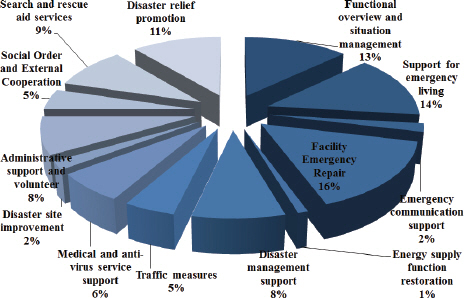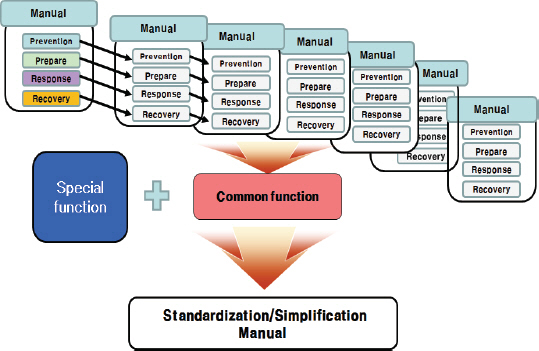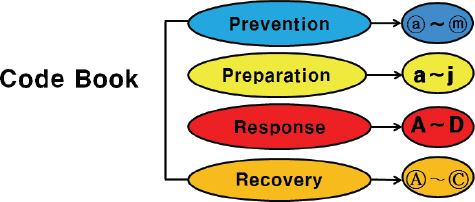|
#1 Functional overview and situation management |
1A |
Functional overview and situation management |
Disaster situation reception and regular monitoring |
1A-1 Conduct of self-evaluation meeting |
|
1A-2 Monitoring of crisis management information, situation synthesis and crisis management activities |
|
Disaster Countermeasures Headquarters Composition Operation |
1A-3 Coordination of disaster and safety management duties |
|
1A-4 Central Disaster Safety Measures Headquarters Installation Operation Instructions |
|
1A-5 Coordination of disaster and safety management duties |
|
1A-6 Operation of local disaster safety measures headquarters |
|
1A-7 Installation and operation of disaster site integration support center |
|
1A-8 Dispatching and dispatching on-site probation coordinator |
|
1B |
Disaster Management General |
Disaster Response and Operation Situation |
1B-1 Situation development, damage detection and continuous response |
|
1B-2 Conducting a comprehensive situation for an accident |
|
1B-3 Emergency response and measurement team |
|
1B-4 Establishment of local emergency command center |
|
1B-5 Proposal for Disaster Prevention |
|
1C |
Operate disaster safety situation room |
|
1C-1 Operate situation room for accident report and technical support |
|
1D |
Collecting and disseminating initial site information and requesting necessary resources |
Providing disaster information and weather information |
1D-1 Detailed weather information of accident area and nearby area |
|
# 2 Support for emergency living |
2A |
Temporary residents and Accommodation support |
Establishment and operation of accommodation facilities for victims |
2A-1 Establishment and operation of accommodation facilities for victims |
|
2A-2 Establishment of ward |
|
2B |
Assisting disaster victims and their families |
Support for victims and bereaved families |
2B-1 Disaster prevention support team activities and support for disaster workers |
|
2B-2 Report missing |
|
2C |
Resident Evacuation Review and Relief activity |
Review and conduct evacuation of residents |
2B-1 Evacuate nearby residents |
|
2B-2 Victim relief activities |
|
#3 Emergency communication support |
3A |
Telecommunication area communication facility restoration and support |
Communication infrastructure |
3A-1 Emergency telephone installation |
|
Establish communication infrastructure |
3A-2 Securing and distributing communication equipment for on-site situation |
|
#4 Facility Emergency Repair |
4A |
Support heavy equipment and manpower for emergency recovery |
Specialist support for emergency recovery |
4A-1 Fire suppression |
|
4A-3 Stop water supply if necessary |
|
Requesting cooperation from the relevant agencies for emergency recovery |
4A-4 Operation of emergency water supply system |
|
4A-5 Conduct emergency rescue |
|
#5 Energy supply function |
5A |
Identify the status of recovery of gas, electric power, and oil facilities and manage the situation |
Request for energy conservation measures and cooperation with related organizations |
5A-1 Preparing energy conservation measures when necessary |
|
5A-2 Emergency power supply |
|
5A-3 Emergency water supply system operation request |
|
5A-4 Safety condition when supplying gas electric material |
|
#6 Disaster management support |
6A |
Comprehensive situation management of disaster material |
Comprehensive disaster material management support |
6A-1 Mobilization of disaster prevention material |
|
6B |
Civil Defense Support |
Identify the status of civil disaster management support |
6B-1 Mobilization of civil defense personnel to prevent the spread of damage |
|
#7 Traffic measures |
7A |
Emergency transport measures and transport safety by securing public transportation |
General road control Dedicated Control |
7A-1 Hazardous area access control |
|
7A-2 Providing transportation for urgent materials and manpower transportation |
|
7B |
Monitoring and information on traffic information |
Traffic situation management |
7B-1 Site control support and accident investigation |
|
#8 Medical and anti-virus services |
8A |
Identify and transport casualties |
Identify and transport casualties |
8A-1 Emergency patient emergency transportation |
|
8B |
Emergency medical center installation and disaster medical support team on-site support |
Injury and follow-up management of casualty emergency |
8B-1 Emergency clinic |
|
8B-2 Emergency medical care for injured persons |
|
8B-3 Post-traumatic stress disorder management |
|
8C |
Supporting the activities to prevent damage to the affected area |
|
8C-1 Contaminated area disaster prevention activity |
|
#9 Disaster site improvement |
9A |
Waste disposal after a disaster |
Disaster waste treatment |
9A-1 Disposal of contaminated goods in accident area |
|
9B |
Identify harmful chemical substances damage and treatment situation |
|
9B-1 Provision of pollutant movement / diffusion prediction and provision of results |
|
#10 Administrative support and volunteer management |
10A |
Supporting and Supporting Local Government Administration |
Death treatment, funeral support and bereavement management |
10A-1 Discussing funeral and compensation matters |
|
10A-2 Confirmation of the death of the survivor |
|
Establishment of autonomous region cooperation system |
10A-3 Communicate directions and meet local requirements through municipal group meetings |
|
10A-4 Review of financial and administrative support for accidental disaster in local communities |
|
10B |
Requesting information on volunteer status and managing information |
Volunteer management |
10B-1 Volunteer input |
|
10C |
Disaster Management Fund Operation |
Emergency budget support and recovery budgeting |
10C-1 Review financial support |
|
10C-2 Support for health insurance fee reduction |
|
10C-3 Suspension of National Pension Payment |
|
10C-4 Financial support for victims and corporate taxpayers |
|
#11 Social Order and External Cooperation |
11A |
Military (manpower, equipment) mobilization consultation and situation grasp |
|
11A-1 Supporting personnel, equipment and lifesaving |
|
11A-2 Coordination of reserves training in affected areas |
|
11B |
Police (manpower, equipment) mobilization consultation and situation grasp |
|
11B-1 Disaster area traffic control and policing |
|
11B-2 Support for rescue and search for missing persons |
|
11C |
Consultation with the school board and the situation |
|
11C-1 Measures such as temporary closure of disaster area |
|
11C-2 Provision of evacuation facilities for school facilities |
|
11D |
Cooperation with related organizations |
|
11D-1 Maintain cooperation system with related organizations |
|
#12 Search and rescue aid services |
12A |
Emergency rescue activity |
Emergency Relief Activities |
12A-1 Life-saving, patient withdrawal and relief |
|
12A-2 Search confirmation |
|
#13 Disaster relief promotion |
13A |
Monitoring citizen opinion on SNS and disseminating distorted information |
|
13A-1Broadcast Disaster Broadcasting and SNS Rapid Broadcasting |
|
13B |
Press releases and press briefings |
Checking the contents of the press and public opinion |
13B-1 Governance efforts to continue publicity |
|
13B-2 Crisis situation vs. national public support |
|
13B-3 Rapidly and accurately spreading the accident situation to the people |
|
13B-4 Strengthen public relations activities to relieve people’s anxiety |
|
13C |
Distribution of complaints by citizens |
|
13C-1 Emergency Promotion Center in operation |
|
13D |
Press media contents, public opinion trend and distorted information online response |
|
13D-1 Response to press release monitoring oboe |






